Dual CANbus monitor and instrumentation cluster. Presently tuned for the Nissan Leaf EV.
Dependencies: SPI_TFTx2_ILI9341 TFT_fonts TOUCH_TFTx2_ILI9341 mbed
Fork of CANary_corrupt by
After adding the LPC1768 platform, import as a program and do not select the "update to latest revision" box
User Guide
Eagle Schematic and Board design
/media/uploads/TickTock/canaryr6.zip
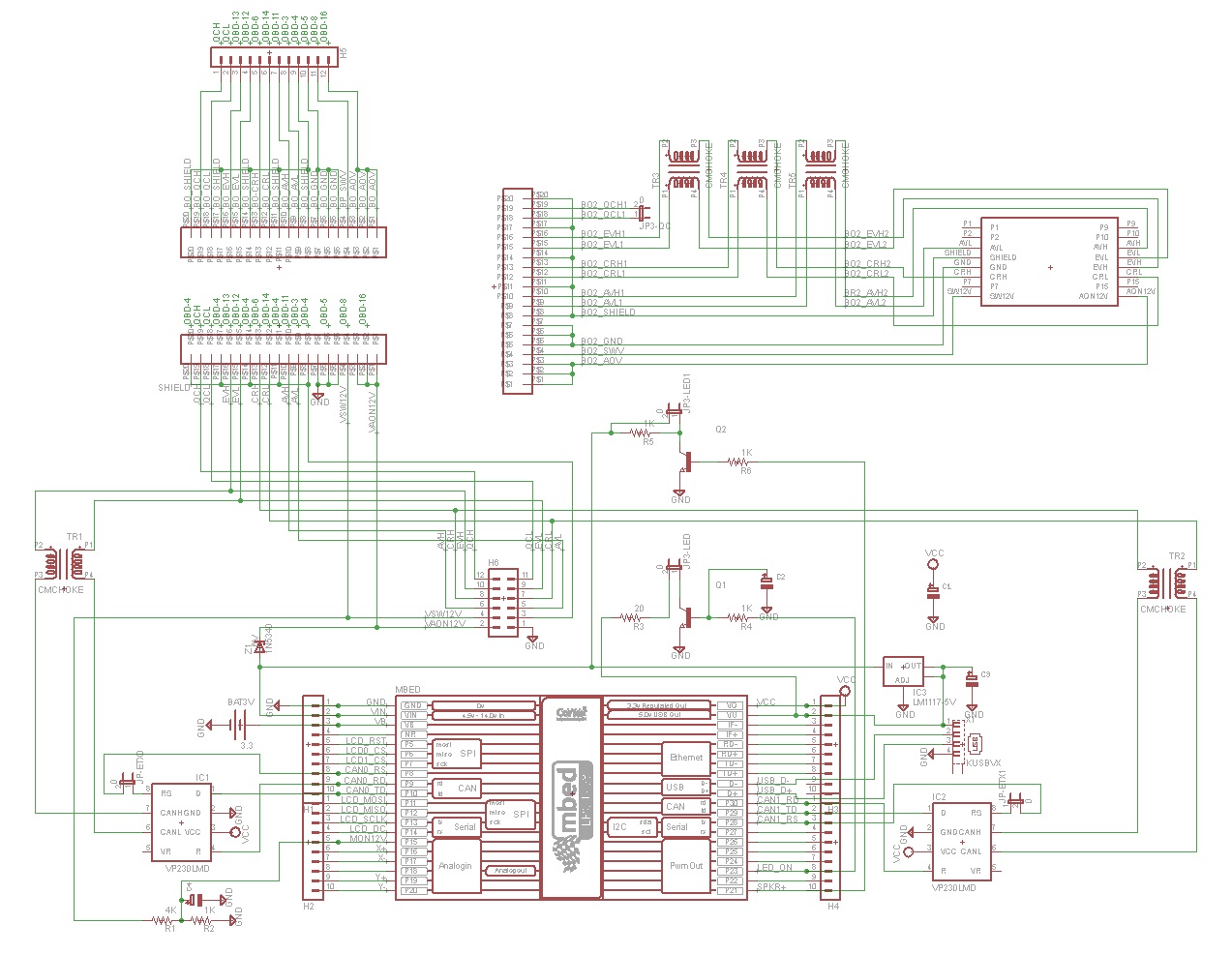
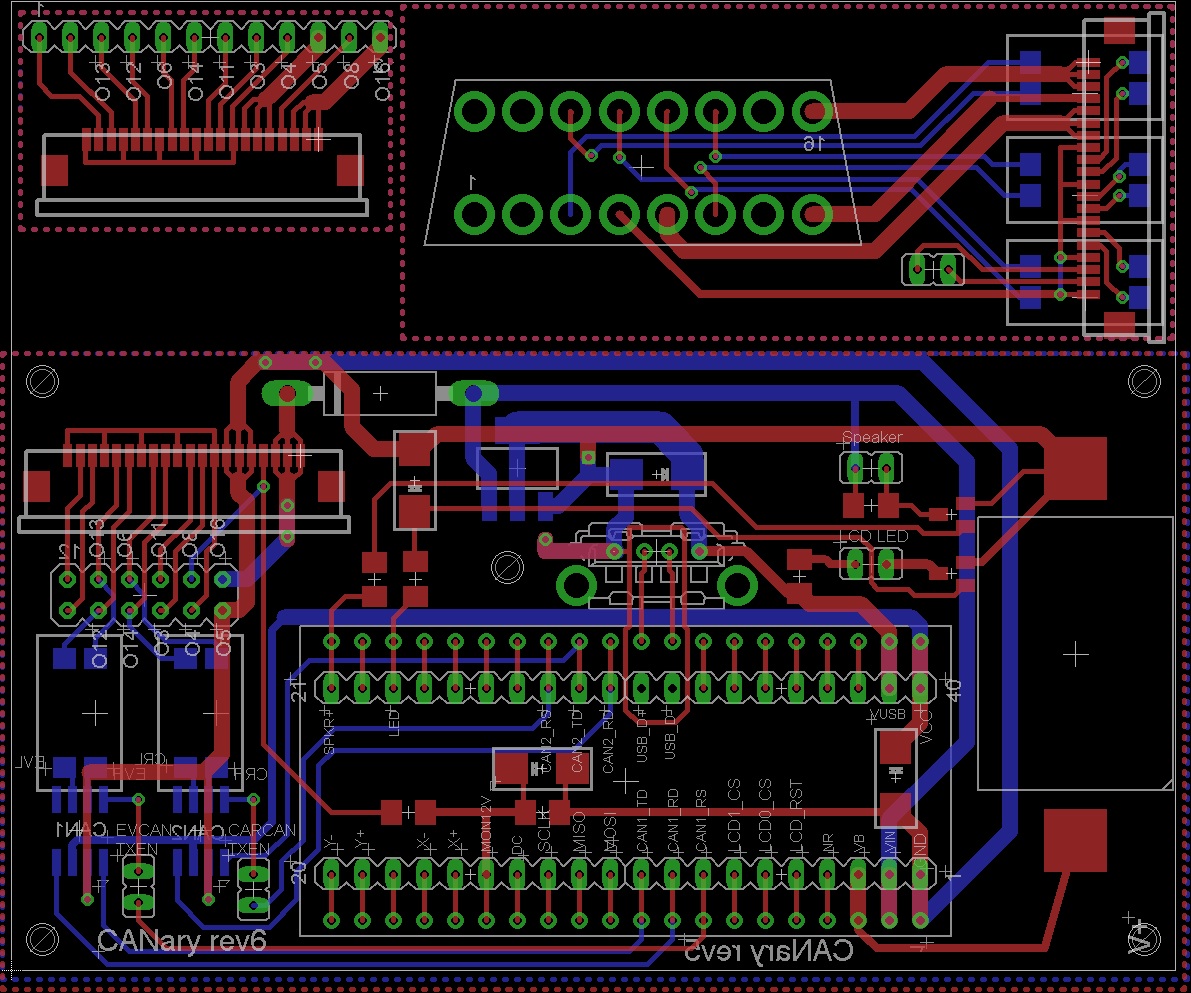
For LCD Rev 1.01:
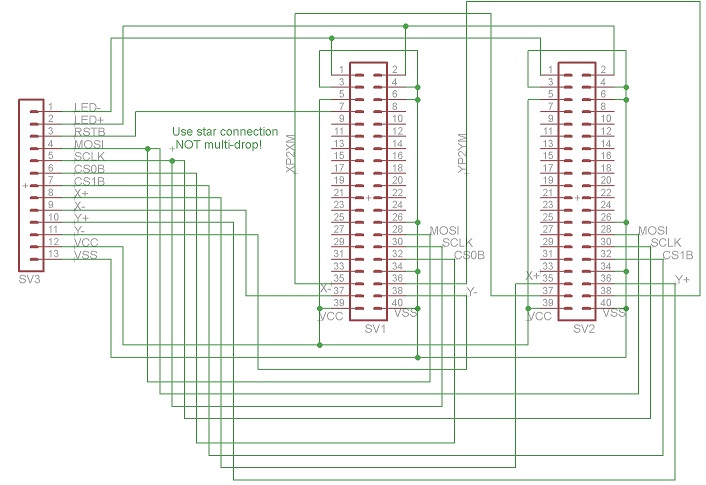
For VCD Rev 2.00:
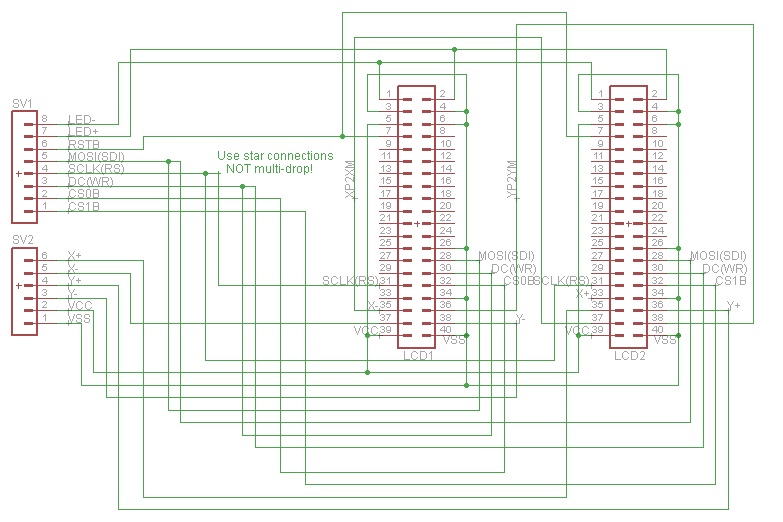
Parts List
Assembly
1) LCD Displays
I found ribbon cable is a nice way to organize the wires to the displays. There are two versions of the display and each must be wired differently. The original project used HW REV. 1.01. For that version, you'll need 12 conductors and I connected them in the following order:
| 1 | LED+ |
| 2 | LED- |
| 3 | RST |
| 4 | SDI |
| 5 | WR/SCLK |
| 6 | CS |
| 7 | X+ |
| 8 | X- |
| 9 | Y+ |
| 10 | Y- |
| 11 | VDD |
| 12 | GND |
If, instead, you have HW REV 2.0, you will need 13 conductors with the following order:
| 1 | LED+ |
| 2 | LED- |
| 3 | RST |
| 4 | SDI |
| 5 | RS (SCLK) |
| 6 | WR (DC) |
| 7 | CS |
| 8 | X+ |
| 9 | X- |
| 10 | Y+ |
| 11 | Y- |
| 12 | VDD |
| 13 | GND |
First I connected all the GND connections (2 GND & IM0, IM1, IM3 for REV1.01 or 2 GND, RD, & IM0 for REV2.00). Do not connect the bottom GND until you have the ribbon cable connected. After making all the ribbon cable connections (connecting the GND of the ribbon cable to the bottom GND pad), solder the GND bar from the previous step to the back of the bottom GND connection. Finally, make a connection from the back side 3.3V pin to IM2 for REV1.01 or to IM1,IM2,&IM3 for REV2.00. Take a break and repeat for the second display.
Examples of REV1.01 boards:
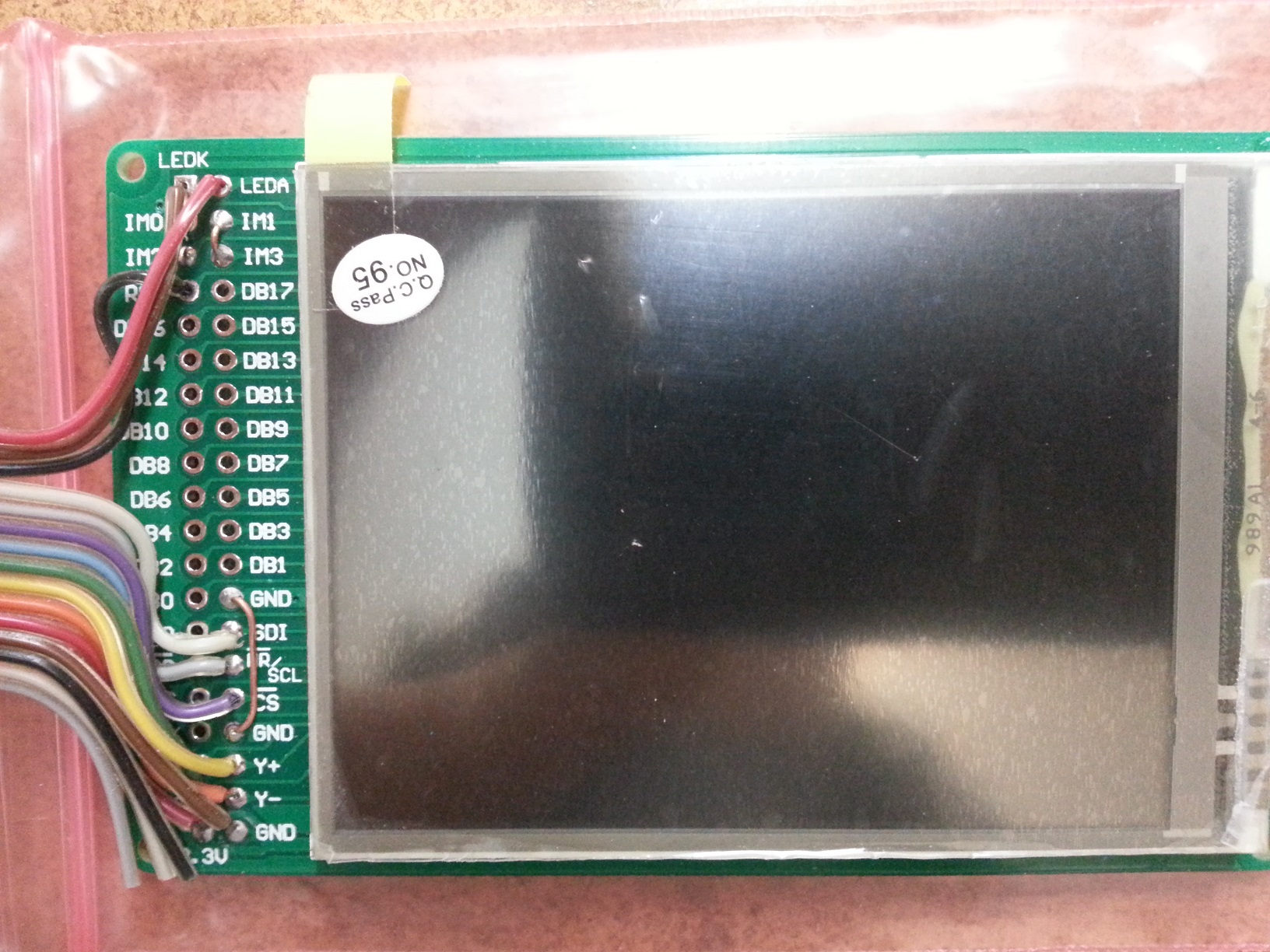
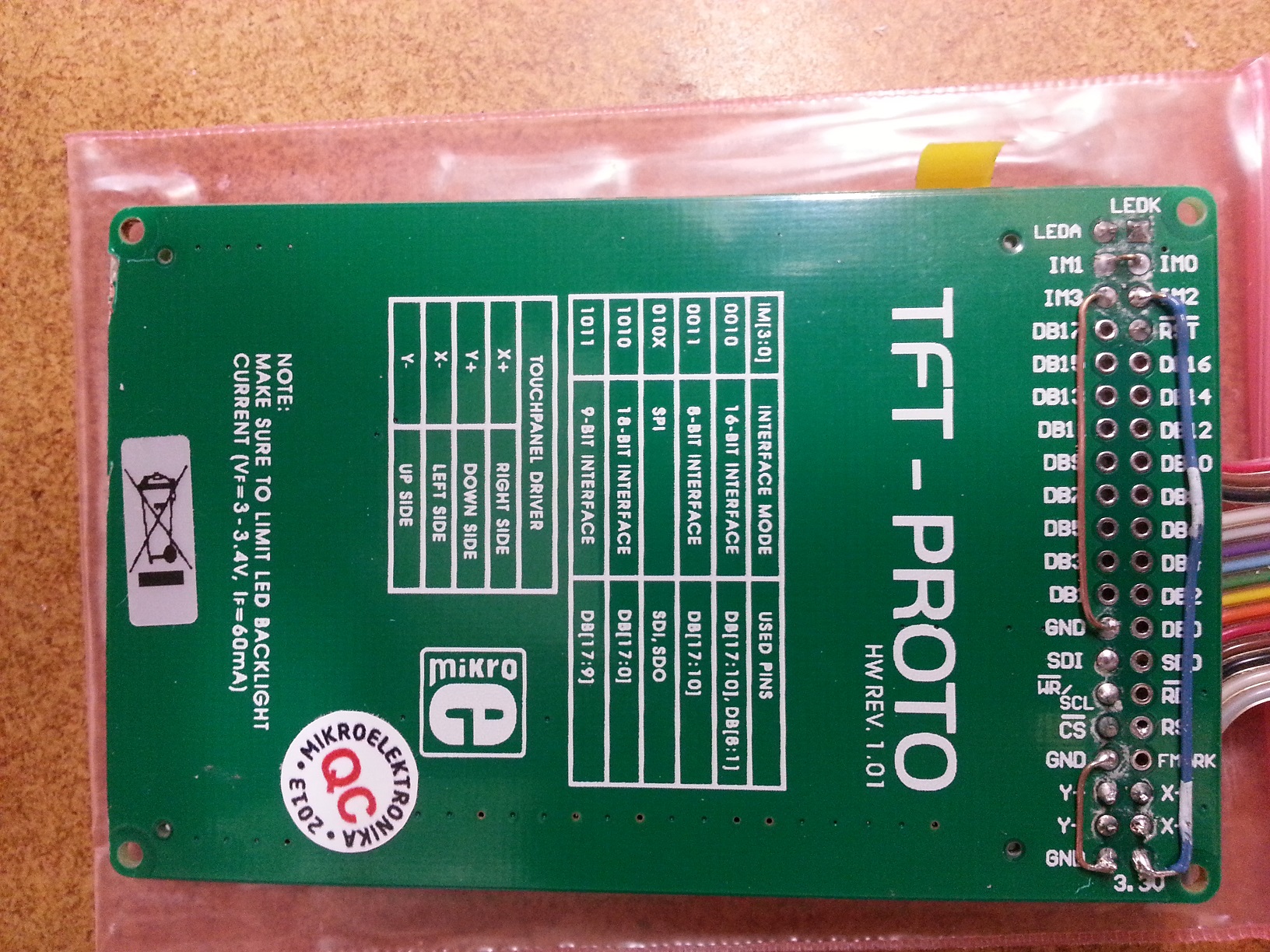
Examples of REV2.00:
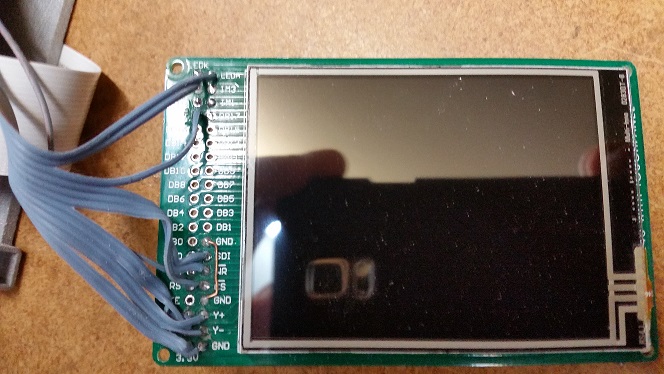

Once the two displays are complete combine all wires except CS0, CS1, X+, X-, Y+, and Y-. Connect X- of the left display to X+ of the right. Similarly connect Y- of the left display to Y+ of the right. Insulate any exposed wires.
2) PCB
Refer to the schematics to place all the components on the board. If you plan to install into the CANary 3D enclosure, DO NOT install the battery holder or the socket for the mbed and, instead, connect two wires to the VB and GND pads nearby. You will have to install the battery holder against the back wall to avoid interfering with the right-hand display and the mbed will have to be directly soldered. I have not found a socket with a low enough profile to fit in the space provided (depth of enclosure is limited by the space behind the center console). Also, I recommend keeping as much lead as possible on the Zener diode (bending it as shown to clear the back wall). Although it is operating well within parameters, the Zener gets quite hot during extended operation and the leads help dissipate the heat and keep it away from the PCB and other components.Update: Several Zeners have failed resulting in damage to some users boards so I recommend using a DC-DC converter instead to bring the 12V down to 7V.
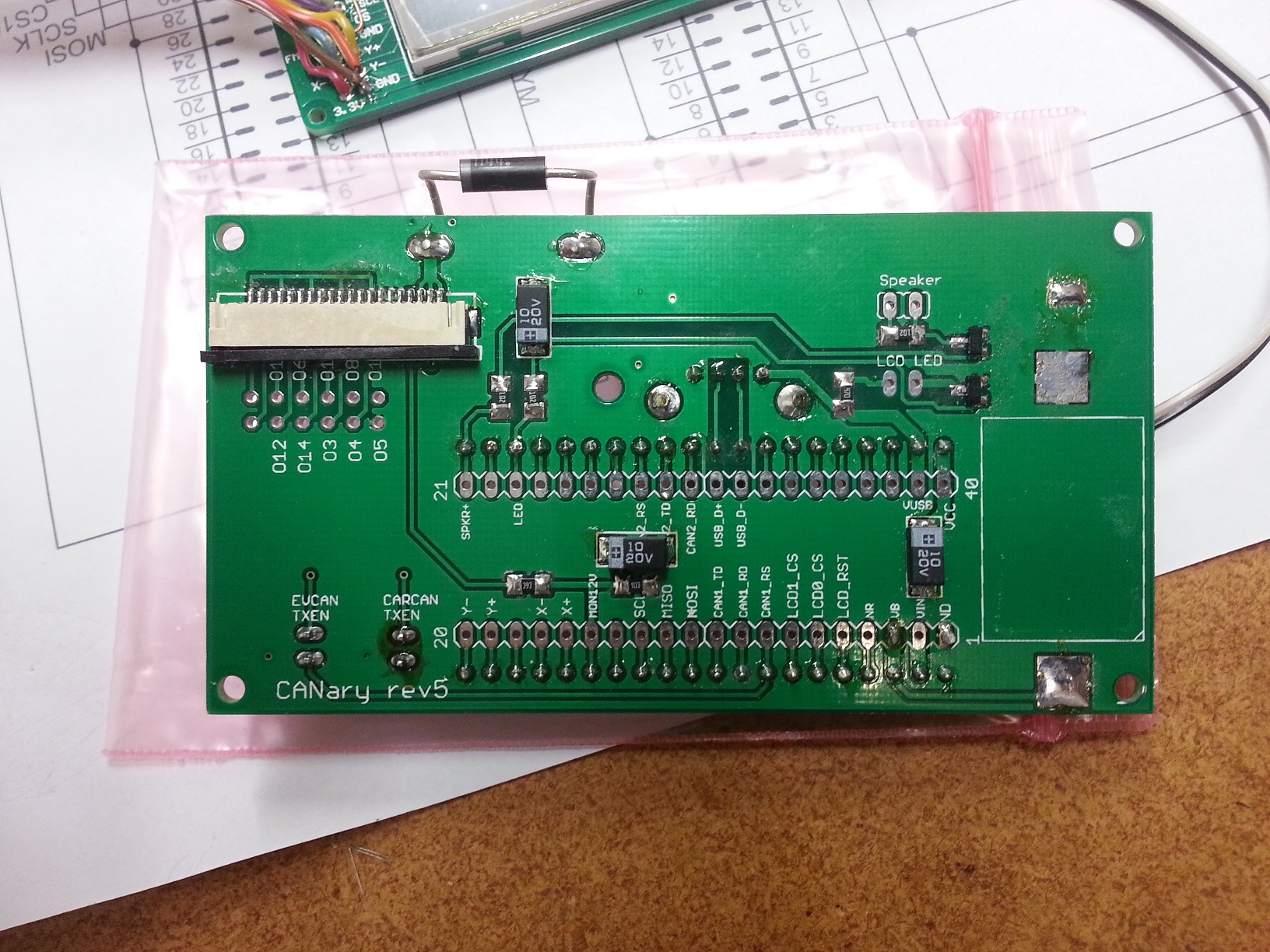
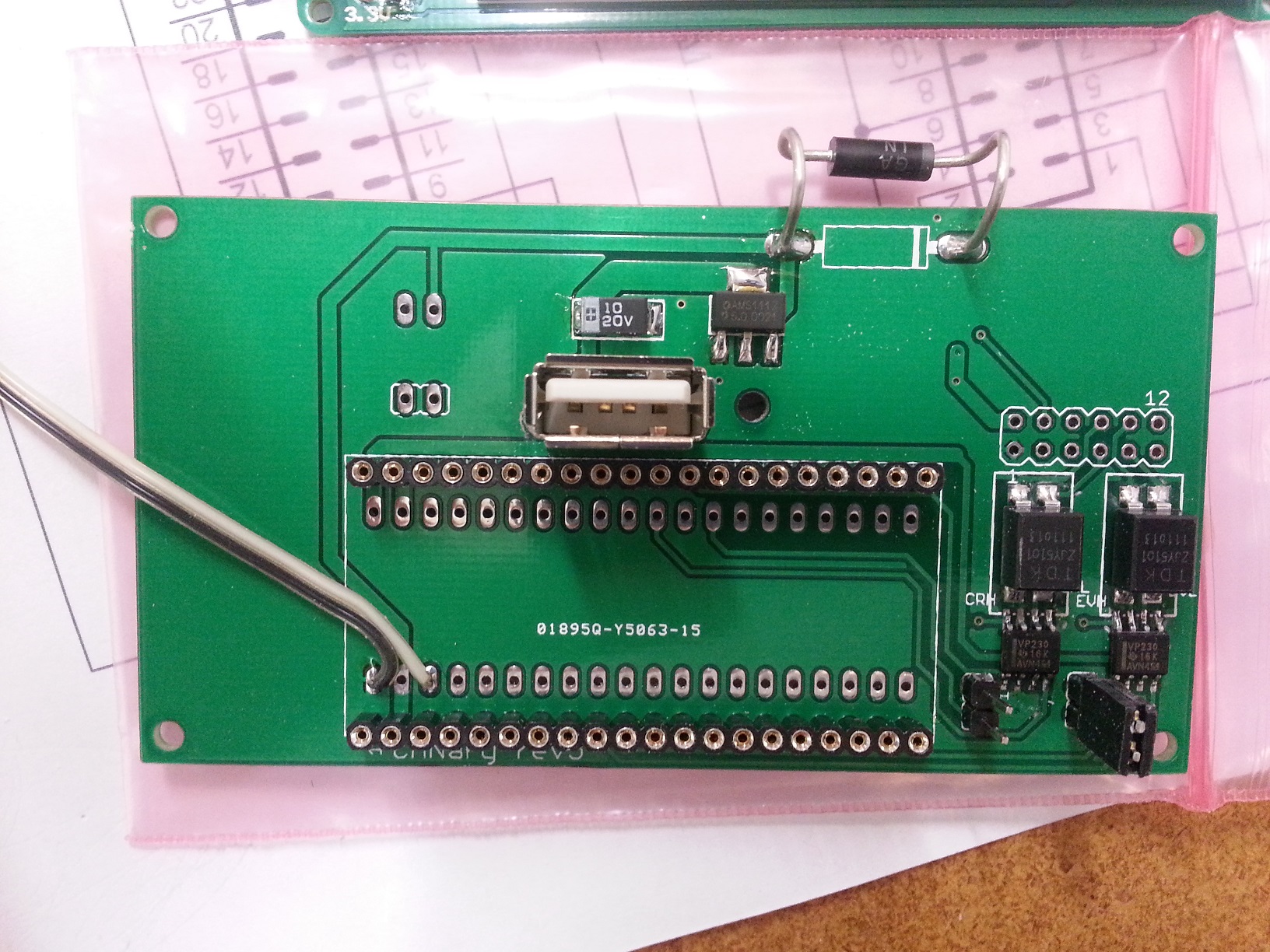
Once the PCB is populated, solder the LCDs to the PCB. CS0 connects to the right display and CS1 connects to the left.
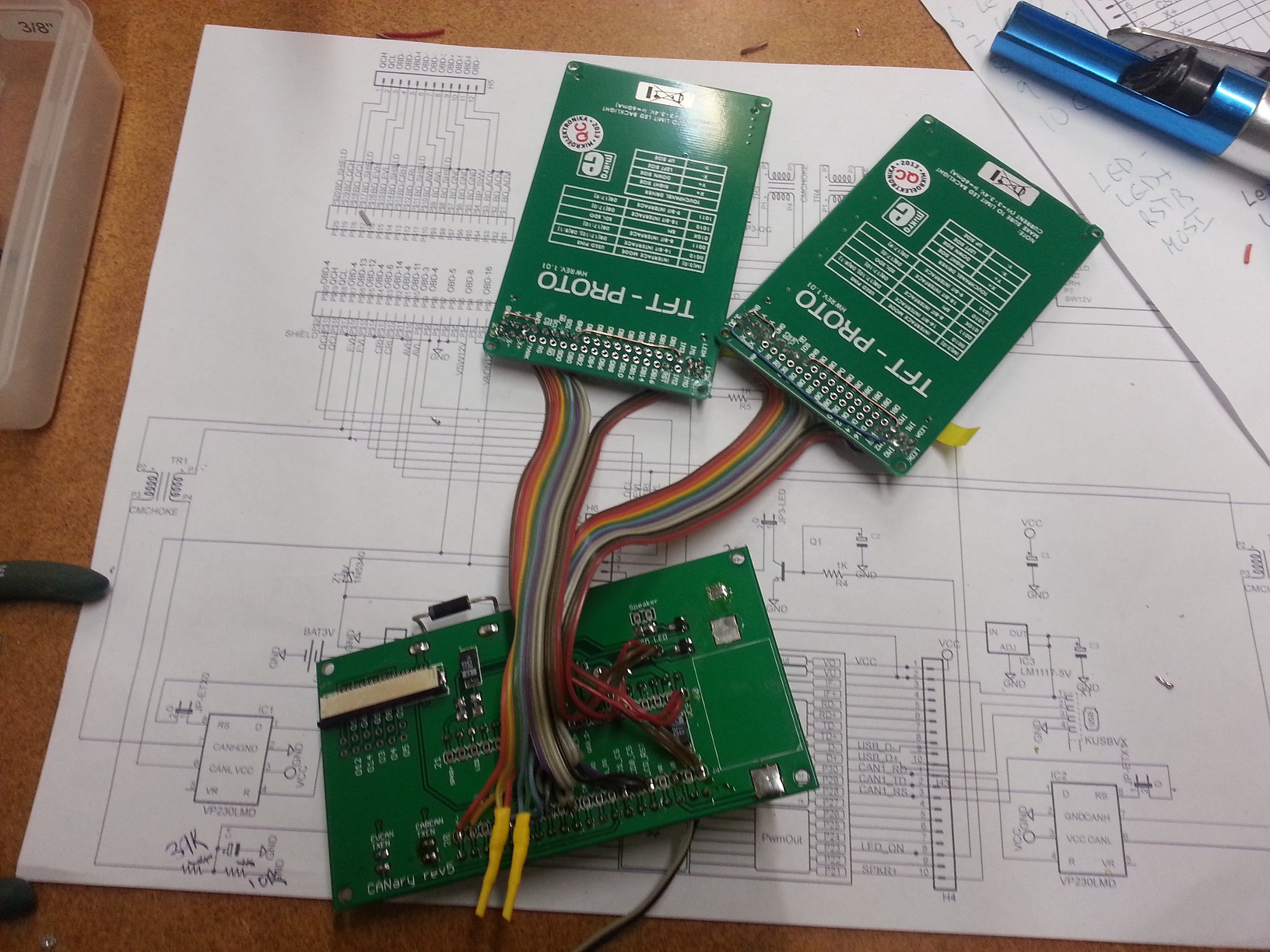
Update:
The Zener diodes tended to fail after a few months so I am recommending removing them and replacing with a DC-DC converter. This will run cooler and waste less energy, too. To install, remove the left display panel to gain access to the Zener. From there, the Zener can be removed and it's pads used to connect to the DC-DC converter. I recommend setting the output voltage on the bench before installing since the trim pot is tricky to reach once installed. Set it to 7V. The input can be connected to the left pad previously occupied by the zener and the output can connect to the right. GND(-) can be connected to the bottom right pad on the 2x6 header below the flex cable connector. Make sure the GND wire lies flat so it doesn't interfere with the connection of the flex cable.
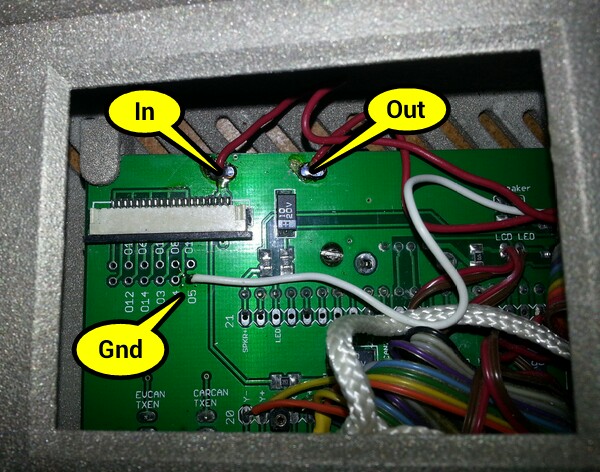
Once soldered in place, the DC-DC converter can easily be mounted to the back wall with double sided tape above the battery holder.
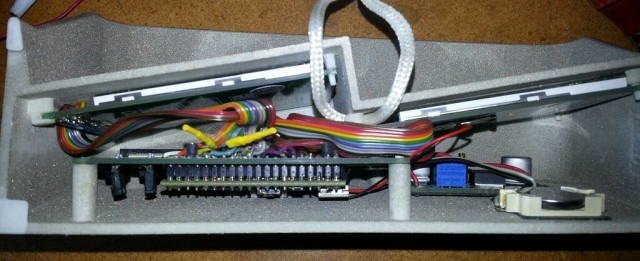
3) Testing
| 1) | First step is to buzz out all connections from the LCDs to the pins in the main board |
| 2) | Next check the touch screen connections. On the main board, place an Ohm meter across X+ and X-. You should read 700 Ohms. Repeat for Y+ and Y-. Then test the resistance from X+ to Y+. With nothing touching the screens, it should read >100K Ohms and <1K when touching either screen. |
| 3) | When all connections are checked, solder in the mbed. Download and install the touch2 program http://mbed.org/users/TickTock/code/touch2/ to test the basic operation of the mbed and touch screens. |
| tips: | |
| Touch screen is sensitive - excess flux on X+,X-,Y+,Y- connection on mbed can result in flakey operation | |
| If touch is not working, double-check the LCD0_CS and LCD1_CS are not swapped. LCD0_CS must connect to the CS of the LCD that has X- & Y- connected to the mbed. LCD1_CS must connect to the CS of the LCD that has X+ & Y+ connected to the mbed. | |
| 4) | Once touch2 works, it is time to connect to the OBD connector. I highly recommend double checking all connections from the OBD to the PCB with the cable in place before connecting to the Leaf. Buzz out all the pins in the OBS to make sure none are shorting to each other, Check that the 12V goes to the Zener (and nothing else) and the switched 12V to the resistor divider (and nothing else). Test the ground connection properly connects to ground and nothing else. |
| 5) | Once you are confident there are no shorts or wrong connections from the OBD connector, take a deep breath and plug it into your leaf. Touch2 program should come up and function. Unplug and install the latest CANary firmware. If you have the REV2.00 LCD boards, you will need to edit the precompile.h file in the TOUCH_TFTx2_w9341 library and set USE_ILI9341 to 1. Test all features before installing into the enclosure (gids, cellpair, menu system, logging) since installing and removing from the enclosure is a PITA. |
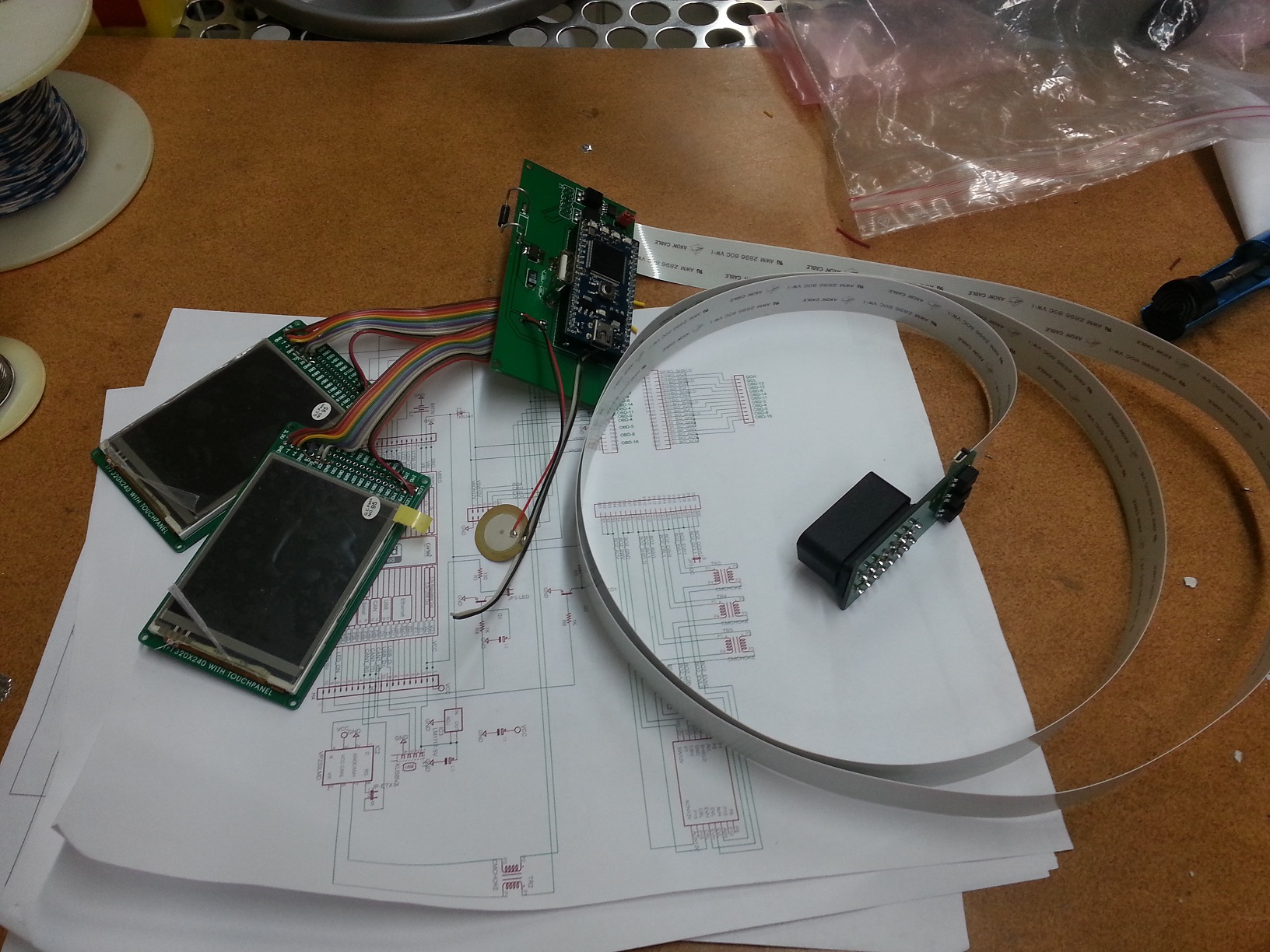
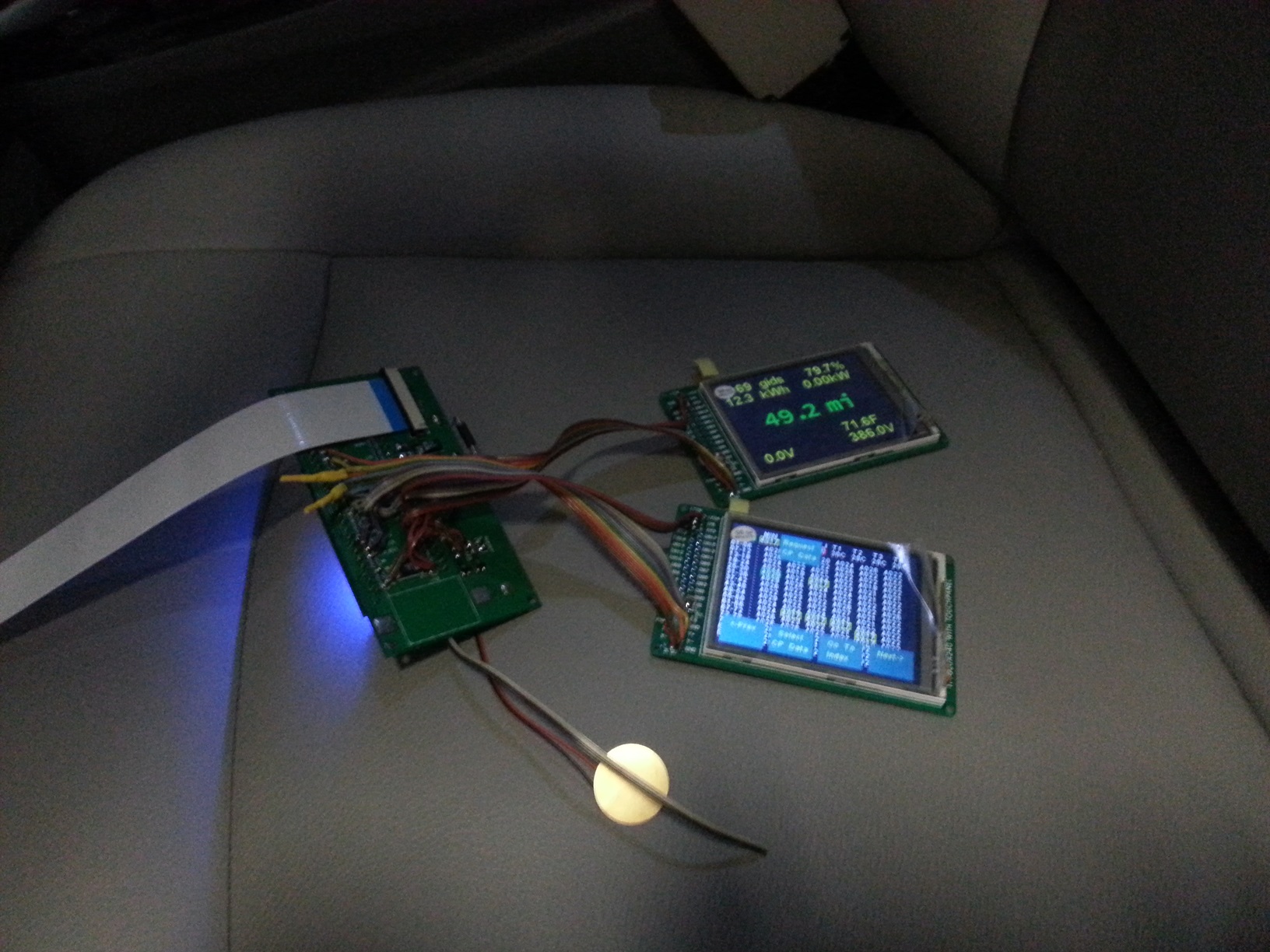
4) Enclosure
The 3D printer leaves a lot of powder behind - I used a strong spray of water to get it out of all the cracks. The enclosure comes with a rather rough finish. I recommend convincing yourself you like it, then simply lightly sand then paint before assembly. Sanding is very difficult - the nylon is very nicely fused and doesn't want to sand. I tried sandblasting and that didn't work either. I had some limited success with filler and then sanding, but only on the outside - it is too difficult to sand the face.

5) Final Assembly
Make sure you are well rested with lots of patience before attempting assembly. It is a puzzle figuring out how to get both displays and the PCB in place. Enclosure was too expensive for me to keep iterating to optimize for assembly. I ended up snipping the thin display posts shorter and using various tools to push the displays into place. Also, some USB connectors are taller than others. If you have one of the taller ones, you will have to deflect the back wall a bit while inserting the PCB (being careful not to bend the housing) to get it to it's opening in the back wall. Do use a screw in the provided post to secure the PCB as USB insertion will otherwise dislodge it.
I added an additional safety line which wraps around the center post to prevent the enclosure from becoming a projectile in the event of an accident.
 Installed:
Installed:

Diff: FatFileSystem/ff.h
- Revision:
- 1:9dcd70c32180
- Parent:
- 0:1596b8644523
- Child:
- 2:71b1999a8ea5
--- a/FatFileSystem/ff.h Mon Nov 19 04:44:11 2012 +0000
+++ /dev/null Thu Jan 01 00:00:00 1970 +0000
@@ -1,344 +0,0 @@
-/*--------------------------------------------------------------------------/
-/ FatFs - FAT file system module include file R0.06 (C)ChaN, 2008
-/---------------------------------------------------------------------------/
-/ FatFs module is an experimenal project to implement FAT file system to
-/ cheap microcontrollers. This is a free software and is opened for education,
-/ research and development under license policy of following trems.
-/
-/ Copyright (C) 2008, ChaN, all right reserved.
-/
-/ * The FatFs module is a free software and there is no warranty.
-/ * You can use, modify and/or redistribute it for personal, non-profit or
-/ commercial use without any restriction under your responsibility.
-/ * Redistributions of source code must retain the above copyright notice.
-/
-/---------------------------------------------------------------------------*/
-
-#ifndef _FATFS
-
-#define _MCU_ENDIAN 2
-/* The _MCU_ENDIAN defines which access method is used to the FAT structure.
-/ 1: Enable word access.
-/ 2: Disable word access and use byte-by-byte access instead.
-/ When the architectural byte order of the MCU is big-endian and/or address
-/ miss-aligned access results incorrect behavior, the _MCU_ENDIAN must be set to 2.
-/ If it is not the case, it can also be set to 1 for good code efficiency. */
-
-#define _FS_READONLY 0
-/* Setting _FS_READONLY to 1 defines read only configuration. This removes
-/ writing functions, f_write, f_sync, f_unlink, f_mkdir, f_chmod, f_rename,
-/ f_truncate and useless f_getfree. */
-
-#define _FS_MINIMIZE 0
-/* The _FS_MINIMIZE option defines minimization level to remove some functions.
-/ 0: Full function.
-/ 1: f_stat, f_getfree, f_unlink, f_mkdir, f_chmod, f_truncate and f_rename are removed.
-/ 2: f_opendir and f_readdir are removed in addition to level 1.
-/ 3: f_lseek is removed in addition to level 2. */
-
-#define _USE_STRFUNC 0
-/* To enable string functions, set _USE_STRFUNC to 1 or 2. */
-
-#define _USE_MKFS 1
-/* When _USE_MKFS is set to 1 and _FS_READONLY is set to 0, f_mkfs function is
-/ enabled. */
-
-#define _DRIVES 4
-/* Number of logical drives to be used. This affects the size of internal table. */
-
-#define _MULTI_PARTITION 0
-/* When _MULTI_PARTITION is set to 0, each logical drive is bound to same
-/ physical drive number and can mount only 1st primaly partition. When it is
-/ set to 1, each logical drive can mount a partition listed in Drives[]. */
-
-#define _USE_FSINFO 0
-/* To enable FSInfo support on FAT32 volume, set _USE_FSINFO to 1. */
-
-#define _USE_SJIS 1
-/* When _USE_SJIS is set to 1, Shift-JIS code transparency is enabled, otherwise
-/ only US-ASCII(7bit) code can be accepted as file/directory name. */
-
-#define _USE_NTFLAG 1
-/* When _USE_NTFLAG is set to 1, upper/lower case of the file name is preserved.
-/ Note that the files are always accessed in case insensitive. */
-
-
-#include "integer.h"
-
-#ifdef __cplusplus
-extern "C" {
-#endif
-
-/* Definitions corresponds to multiple sector size (not tested) */
-#define S_MAX_SIZ 512U /* Do not change */
-#if S_MAX_SIZ > 512U
-#define SS(fs) ((fs)->s_size)
-#else
-#define SS(fs) 512U
-#endif
-
-
-/* File system object structure */
-typedef struct _FATFS {
- WORD id; /* File system mount ID */
- WORD n_rootdir; /* Number of root directory entries */
- DWORD winsect; /* Current sector appearing in the win[] */
- DWORD sects_fat; /* Sectors per fat */
- DWORD max_clust; /* Maximum cluster# + 1 */
- DWORD fatbase; /* FAT start sector */
- DWORD dirbase; /* Root directory start sector (cluster# for FAT32) */
- DWORD database; /* Data start sector */
-#if !_FS_READONLY
- DWORD last_clust; /* Last allocated cluster */
- DWORD free_clust; /* Number of free clusters */
-#if _USE_FSINFO
- DWORD fsi_sector; /* fsinfo sector */
- BYTE fsi_flag; /* fsinfo dirty flag (1:must be written back) */
- BYTE pad2;
-#endif
-#endif
- BYTE fs_type; /* FAT sub type */
- BYTE csize; /* Number of sectors per cluster */
-#if S_MAX_SIZ > 512U
- WORD s_size; /* Sector size */
-#endif
- BYTE n_fats; /* Number of FAT copies */
- BYTE drive; /* Physical drive number */
- BYTE winflag; /* win[] dirty flag (1:must be written back) */
- BYTE pad1;
- BYTE win[S_MAX_SIZ]; /* Disk access window for Directory/FAT */
-} FATFS;
-
-
-/* Directory object structure */
-typedef struct _DIR {
- WORD id; /* Owner file system mount ID */
- WORD index; /* Current index */
- FATFS* fs; /* Pointer to the owner file system object */
- DWORD sclust; /* Start cluster */
- DWORD clust; /* Current cluster */
- DWORD sect; /* Current sector */
-} FATFS_DIR;
-
-
-/* File object structure */
-typedef struct _FIL {
- WORD id; /* Owner file system mount ID */
- BYTE flag; /* File status flags */
- BYTE csect; /* Sector address in the cluster */
- FATFS* fs; /* Pointer to the owner file system object */
- DWORD fptr; /* File R/W pointer */
- DWORD fsize; /* File size */
- DWORD org_clust; /* File start cluster */
- DWORD curr_clust; /* Current cluster */
- DWORD curr_sect; /* Current sector */
-#if _FS_READONLY == 0
- DWORD dir_sect; /* Sector containing the directory entry */
- BYTE* dir_ptr; /* Ponter to the directory entry in the window */
-#endif
- BYTE buffer[S_MAX_SIZ]; /* File R/W buffer */
-} FIL;
-
-
-/* File status structure */
-typedef struct _FILINFO {
- DWORD fsize; /* Size */
- WORD fdate; /* Date */
- WORD ftime; /* Time */
- BYTE fattrib; /* Attribute */
- char fname[8+1+3+1]; /* Name (8.3 format) */
-} FILINFO;
-
-
-
-/* Definitions corresponds to multi partition */
-
-#if _MULTI_PARTITION != 0 /* Multiple partition cfg */
-
-typedef struct _PARTITION {
- BYTE pd; /* Physical drive # (0-255) */
- BYTE pt; /* Partition # (0-3) */
-} PARTITION;
-extern
-const PARTITION Drives[]; /* Logical drive# to physical location conversion table */
-#define LD2PD(drv) (Drives[drv].pd) /* Get physical drive# */
-#define LD2PT(drv) (Drives[drv].pt) /* Get partition# */
-
-#else /* Single partition cfg */
-
-#define LD2PD(drv) (drv) /* Physical drive# is equal to logical drive# */
-#define LD2PT(drv) 0 /* Always mounts the 1st partition */
-
-#endif
-
-
-/* File function return code (FRESULT) */
-
-typedef enum {
- FR_OK = 0, /* 0 */
- FR_NOT_READY, /* 1 */
- FR_NO_FILE, /* 2 */
- FR_NO_PATH, /* 3 */
- FR_INVALID_NAME, /* 4 */
- FR_INVALID_DRIVE, /* 5 */
- FR_DENIED, /* 6 */
- FR_EXIST, /* 7 */
- FR_RW_ERROR, /* 8 */
- FR_WRITE_PROTECTED, /* 9 */
- FR_NOT_ENABLED, /* 10 */
- FR_NO_FILESYSTEM, /* 11 */
- FR_INVALID_OBJECT, /* 12 */
- FR_MKFS_ABORTED /* 13 */
-} FRESULT;
-
-
-
-/*-----------------------------------------------------*/
-/* FatFs module application interface */
-
-FRESULT f_mount (BYTE, FATFS*); /* Mount/Unmount a logical drive */
-FRESULT f_open (FIL*, const char*, BYTE); /* Open or create a file */
-FRESULT f_read (FIL*, void*, UINT, UINT*); /* Read data from a file */
-FRESULT f_write (FIL*, const void*, UINT, UINT*); /* Write data to a file */
-FRESULT f_lseek (FIL*, DWORD); /* Move file pointer of a file object */
-FRESULT f_close (FIL*); /* Close an open file object */
-FRESULT f_opendir (FATFS_DIR*, const char*); /* Open an existing directory */
-FRESULT f_readdir (FATFS_DIR*, FILINFO*); /* Read a directory item */
-FRESULT f_stat (const char*, FILINFO*); /* Get file status */
-FRESULT f_getfree (const char*, DWORD*, FATFS**); /* Get number of free clusters on the drive */
-FRESULT f_truncate (FIL*); /* Truncate file */
-FRESULT f_sync (FIL*); /* Flush cached data of a writing file */
-FRESULT f_unlink (const char*); /* Delete an existing file or directory */
-FRESULT f_mkdir (const char*); /* Create a new directory */
-FRESULT f_chmod (const char*, BYTE, BYTE); /* Change file/dir attriburte */
-FRESULT f_utime (const char*, const FILINFO*); /* Change file/dir timestamp */
-FRESULT f_rename (const char*, const char*); /* Rename/Move a file or directory */
-FRESULT f_mkfs (BYTE, BYTE, WORD); /* Create a file system on the drive */
-#if _USE_STRFUNC
-#define feof(fp) ((fp)->fptr == (fp)->fsize)
-#define EOF -1
-int fputc (int, FIL*); /* Put a character to the file */
-int fputs (const char*, FIL*); /* Put a string to the file */
-int fprintf (FIL*, const char*, ...); /* Put a formatted string to the file */
-char* fgets (char*, int, FIL*); /* Get a string from the file */
-#endif
-
-/* User defined function to give a current time to fatfs module */
-
-DWORD get_fattime (void); /* 31-25: Year(0-127 org.1980), 24-21: Month(1-12), 20-16: Day(1-31) */
- /* 15-11: Hour(0-23), 10-5: Minute(0-59), 4-0: Second(0-29 *2) */
-
-
-
-/* File access control and file status flags (FIL.flag) */
-
-#define FA_READ 0x01
-#define FA_OPEN_EXISTING 0x00
-#if _FS_READONLY == 0
-#define FA_WRITE 0x02
-#define FA_CREATE_NEW 0x04
-#define FA_CREATE_ALWAYS 0x08
-#define FA_OPEN_ALWAYS 0x10
-#define FA__WRITTEN 0x20
-#define FA__DIRTY 0x40
-#endif
-#define FA__ERROR 0x80
-
-
-/* FAT sub type (FATFS.fs_type) */
-
-#define FS_FAT12 1
-#define FS_FAT16 2
-#define FS_FAT32 3
-
-
-/* File attribute bits for directory entry */
-
-#define AM_RDO 0x01 /* Read only */
-#define AM_HID 0x02 /* Hidden */
-#define AM_SYS 0x04 /* System */
-#define AM_VOL 0x08 /* Volume label */
-#define AM_LFN 0x0F /* LFN entry */
-#define AM_DIR 0x10 /* Directory */
-#define AM_ARC 0x20 /* Archive */
-
-
-
-/* Offset of FAT structure members */
-
-#define BS_jmpBoot 0
-#define BS_OEMName 3
-#define BPB_BytsPerSec 11
-#define BPB_SecPerClus 13
-#define BPB_RsvdSecCnt 14
-#define BPB_NumFATs 16
-#define BPB_RootEntCnt 17
-#define BPB_TotSec16 19
-#define BPB_Media 21
-#define BPB_FATSz16 22
-#define BPB_SecPerTrk 24
-#define BPB_NumHeads 26
-#define BPB_HiddSec 28
-#define BPB_TotSec32 32
-#define BS_55AA 510
-
-#define BS_DrvNum 36
-#define BS_BootSig 38
-#define BS_VolID 39
-#define BS_VolLab 43
-#define BS_FilSysType 54
-
-#define BPB_FATSz32 36
-#define BPB_ExtFlags 40
-#define BPB_FSVer 42
-#define BPB_RootClus 44
-#define BPB_FSInfo 48
-#define BPB_BkBootSec 50
-#define BS_DrvNum32 64
-#define BS_BootSig32 66
-#define BS_VolID32 67
-#define BS_VolLab32 71
-#define BS_FilSysType32 82
-
-#define FSI_LeadSig 0
-#define FSI_StrucSig 484
-#define FSI_Free_Count 488
-#define FSI_Nxt_Free 492
-
-#define MBR_Table 446
-
-#define DIR_Name 0
-#define DIR_Attr 11
-#define DIR_NTres 12
-#define DIR_CrtTime 14
-#define DIR_CrtDate 16
-#define DIR_FstClusHI 20
-#define DIR_WrtTime 22
-#define DIR_WrtDate 24
-#define DIR_FstClusLO 26
-#define DIR_FileSize 28
-
-
-
-/* Multi-byte word access macros */
-
-#if _MCU_ENDIAN == 1 /* Use word access */
-#define LD_WORD(ptr) (WORD)(*(WORD*)(BYTE*)(ptr))
-#define LD_DWORD(ptr) (DWORD)(*(DWORD*)(BYTE*)(ptr))
-#define ST_WORD(ptr,val) *(WORD*)(BYTE*)(ptr)=(WORD)(val)
-#define ST_DWORD(ptr,val) *(DWORD*)(BYTE*)(ptr)=(DWORD)(val)
-#elif _MCU_ENDIAN == 2 /* Use byte-by-byte access */
-#define LD_WORD(ptr) (WORD)(((WORD)*(volatile BYTE*)((ptr)+1)<<8)|(WORD)*(volatile BYTE*)(ptr))
-#define LD_DWORD(ptr) (DWORD)(((DWORD)*(volatile BYTE*)((ptr)+3)<<24)|((DWORD)*(volatile BYTE*)((ptr)+2)<<16)|((WORD)*(volatile BYTE*)((ptr)+1)<<8)|*(volatile BYTE*)(ptr))
-#define ST_WORD(ptr,val) *(volatile BYTE*)(ptr)=(BYTE)(val); *(volatile BYTE*)((ptr)+1)=(BYTE)((WORD)(val)>>8)
-#define ST_DWORD(ptr,val) *(volatile BYTE*)(ptr)=(BYTE)(val); *(volatile BYTE*)((ptr)+1)=(BYTE)((WORD)(val)>>8); *(volatile BYTE*)((ptr)+2)=(BYTE)((DWORD)(val)>>16); *(volatile BYTE*)((ptr)+3)=(BYTE)((DWORD)(val)>>24)
-#else
-#error Do not forget to set _MCU_ENDIAN properly!
-#endif
-
-#ifdef __cplusplus
-};
-#endif
-
-#define _FATFS
-#endif /* _FATFS */
